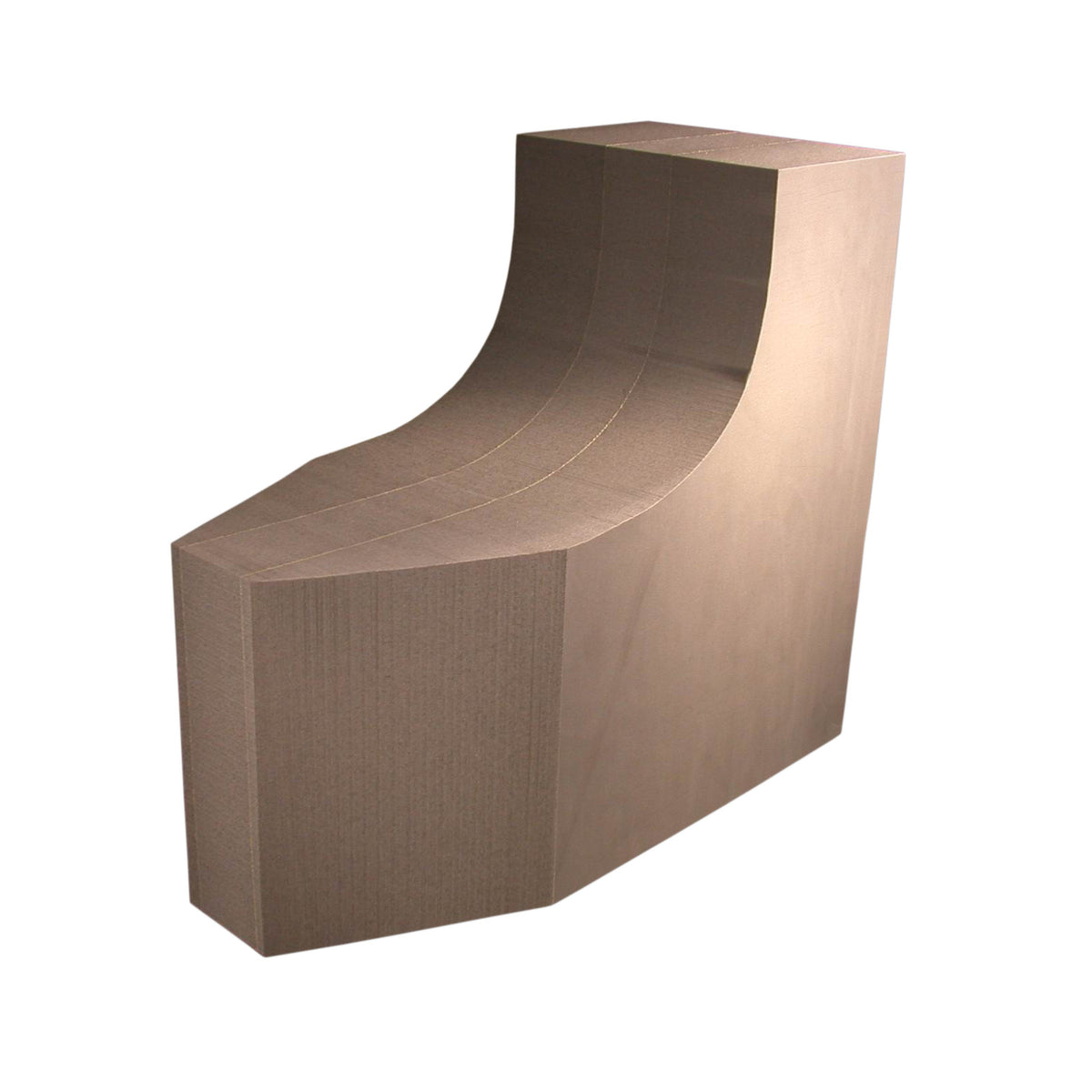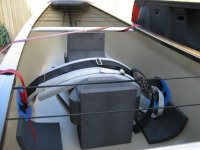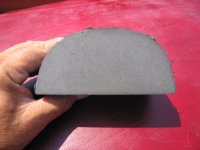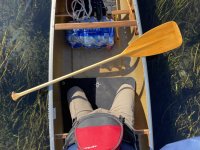I've got chronic sciatica, and multiple compressed or ruptured discs as well as severed nerves, and kneeling for me is absolute torture because it forces the lower back to curve, further loading up on the injuries, what works for me is my kneeling thwart is lowered and angled so I can use it for a toe bar, essentially locking me in place.I kneel about half the time because it takes all the pressure off my lower back. If anyone has compressed discs or problems with sciatica, then kneeling is the perfect solution. My ability to be in a boat for a long time is a function of being able to change position frequently. Whenever I kneel in a canoe it reminds me of my father, who didn't canoe, but was able to spend extended periods kneeling on the ground, thigh and shin folded flat, with feet folded over each other. For me it comes naturally because I've done it all my life, but I imagine if you haven't it takes some getting used to over time. Bucking firewood with a chainsaw on the ground is easy for me, but most people struggle.
Mark
-
Happy Science Fiction Day; and Birthday, Isaac Asimov (1920-92)! 🚀🌌🤖
You are using an out of date browser. It may not display this or other websites correctly.
You should upgrade or use an alternative browser.
You should upgrade or use an alternative browser.
Kneeling Part 1
- Thread starter Marc Ornstein
- Start date
The only time I kneel is when I am in waves towering over my head and I have decided that God might actually exist if I supplicate myself and pray. Just kidd'n, I never kneel.
Hmm? I must be in a different position when kneeling. It sounds like you have your back arched when kneeling. When I'm kneeling and paddling I am reaching out further in front with the paddle and my lower back is rounded, or in flexion. That is what opens up the passages where the sciatic nerves exit the spine. This is instant lower back relief for me. I don't do this forever though, and eventually go back to sitting on the seat. With sitting, my core muscles eventually fatigue and my back starts to arch again, with the pain coming back. I can't visualize the kneeling thwart/toe bar thing you describe. Do you mind describing that further?I've got chronic sciatica, and multiple compressed or ruptured discs as well as severed nerves, and kneeling for me is absolute torture because it forces the lower back to curve, further loading up on the injuries, what works for me is my kneeling thwart is lowered and angled so I can use it for a toe bar, essentially locking me in place.
no it's because kneeling forces a tilt to the pelvis and actually closes the gap in the lowest vertebrae to combat the body's natural tendency to lean forward into a 90 degree bend, which results in an exaggerated S curveHmm? I must be in a different position when kneeling. It sounds like you have your back arched when kneeling. When I'm kneeling and paddling I am reaching out further in front with the paddle and my lower back is rounded, or in flexion. That is what opens up the passages where the sciatic nerves exit the spine. This is instant lower back relief for me. I don't do this forever though, and eventually go back to sitting on the seat. With sitting, my core muscles eventually fatigue and my back starts to arch again, with the pain coming back. I can't visualize the kneeling thwart/toe bar thing you describe. Do you mind describing that further?
the kneeling thwart is normally about 16-18" behind the centre thwart and is a contoured thwart usually mounted just below the gunnels, Mine has been shifted farther back, tilted, and lowered considerably to match the length of my legs and height of my foot so when seated my toes push against it, giving me far more stability by creating a triangle between my hips and feet.
Lets call it a work in progress. But the important part is paddling no matter what the postureWell, yesterday's test confirmed...my newly replaced knee is not yet ready for kneeling. It's too early to tell if it ever will be, but for now I had to stay on the seat. View attachment 127467
Amen to that.Lets call it a work in progress. But the important part is paddling no matter what the posture
And I did carry that canoe down the trail to the lake, and at 60+ pounds that’s a good milestone on the knee.
Despite being extremely uncomfortable kneeling on the ground, or kneeling with my rear resting on my legs per 'Canadian freestyle', which immediately puts my feet to sleep, I finally starting trying to kneel in my canoe using the seat and have found it quite a revelation in comfort (with respect for those who say it doesn't work for them - everyone's different!). Before, I used to alternate between sitting and standing, as well as frequently moving legs this way and that, to keep them from going to sleep. Now I'm looking to re-outfit my canoe for more kneeling, though I would still like to be able to sit or stand depending on conditions and needs (poling, photography, bird-watching, etc).
My seats are very low hung (Wenonah Heron with factory aluminum drops), so I've been playing with raising the height by adding seat pads of varying thickness on the seat (as well as padding for knees).
What's the advantage of a kneeling thwart over a seat? Can I angle the seat instead of installing a kneeling thwart? Or just add an angled pad (maybe cut from minicell foam) to the seat? I'm able to get my feet under the seat and back out without much trouble, so the height adjustment is just to get my rear end at the proper height, not to fit my feet under it.
My seats are very low hung (Wenonah Heron with factory aluminum drops), so I've been playing with raising the height by adding seat pads of varying thickness on the seat (as well as padding for knees).
What's the advantage of a kneeling thwart over a seat? Can I angle the seat instead of installing a kneeling thwart? Or just add an angled pad (maybe cut from minicell foam) to the seat? I'm able to get my feet under the seat and back out without much trouble, so the height adjustment is just to get my rear end at the proper height, not to fit my feet under it.
Yes you can angle the seat. A contoured front rail on the seat helps too. I try to adjust the cant and height to maintain about 60+% of my weight on the seat.
Kneeling thwart is usually used as a third position in a tandem to facilitate solo paddling but you certainly could use one instead of a seat. It would be lighter but in my experience not nearly as comfortable.
Kneeling thwart is usually used as a third position in a tandem to facilitate solo paddling but you certainly could use one instead of a seat. It would be lighter but in my experience not nearly as comfortable.
- Joined
- Nov 22, 2021
- Messages
- 379
- Reaction score
- 565
I don't kneel. Period. A few hours of kneeling and I have sore knees for a week. I want to learn a lot of the freestyle stuff, but sitting puts me at a serious disadvantage. I'm going to experiment with different set-ups and see if I can find a way of kneeling that doesn't make me a cripple.We have a new article, by Tim Burris, in the Crosspost, the journal of the Freestyle Committee of the United States Canoeing Association. It is titled KNEELING PART 1 and is the 1st of a 3 part series. This article and many more are available for viewing at https://freestylecanoeing.com/blog/
What is a saddle?
What is a saddle?

Canoe Saddle
Weight placement is critical in all canoes and particularly in today's shorter whitewater solo canoes. An inch too far forward or back throws the whole boat’s performance off. The size of this saddle allows you to lean farther forward for micro-surfing, enabling more reach and weight into your...
northwater.com
Usually shaped to fit the person and boat. Kneel while straddled like a horse saddle.
I think he was probably referring to a foam pedestal like most whitewater open boaters use. Usually constructed from minicell foam these days, they come in different shapes and designs. Below is shown one type which also has a belt that functions as a thigh strap. Obviously, you can use the pedestal without the strap if you wish. A pedestal does have the advantage of presenting less of an entrapment hazard as you do not need to get your feet out from under anything if you capsize. On the other hand you are sort of confined to a central position. You can't slide over toward one gunwale or keep your heels close together if you like to do those sorts of things.What is a saddle?

One thing that I did not see mentioned in this thread that can make kneeling more comfortable is the use of ankle blocks. These can be made out of minicell in any height and shape that best suits and I have seen a lot of variations. I usually use a simple half circle shape as below. In whitewater boats I glue these in with contact cement but they can also be attached with Velcro or left loose and positioned or repositioned to suit.

Thanks all!!!
This guy out of California has a great system to improve knee function and flexibility. The towel behind the knees helped rehab my knees..
This guy out of California has a great system to improve knee function and flexibility. The towel behind the knees helped rehab my knees..
Welcome to site membership, twobells! Feel free to ask any questions and to post messages, photos and videos in our many forums. We look forward to your participation in our canoe community.
My limiting pain factor has been my inflexibility, especially of the ankles. Several folks here and in the BCUSA paddling sub suggested using a pool noodle under the ankles to take some of the pressure off, and wow did that ever make a difference. I’m able to paddle kneeling for quite a while now, 30-45 minutes at a time. I love the control and flexibility! I love that it doesn’t matter if the boat tilts while paddling, I still feel very secure. And to give the tushy a break, you can “stand up” on your knees. Getting past that ankle discomfort was key.


I use a 3" thick piece of foam for kneeling. You would probably use it similar to the pool noodle but it has more surface area and would give you more options. The 3" height makes it more comfortable kneeling from a high seat or thwart. I also vary how I use it which changes the pressure points. I can kneel with my kneecaps on it and the balls of my feet on the floor. Mostly though I rest my shins on it, sometimes closer to my knees and sometimes closer to my ankles. It takes the weight off of your ankles and lets you keep them at a more comfortable angle.
It makes kneeling without the use of a seat or thwart more doable enabling you to paddle from anywhere in the boat. I also use it for a seat when sitting on the bottom of the boat while leaning my back on a seat or thwart, very comfortable. I also use it to sit on when paddling backwards from the bow seat and need the height to clear the bow thwart with my legs.
It makes kneeling without the use of a seat or thwart more doable enabling you to paddle from anywhere in the boat. I also use it for a seat when sitting on the bottom of the boat while leaning my back on a seat or thwart, very comfortable. I also use it to sit on when paddling backwards from the bow seat and need the height to clear the bow thwart with my legs.
I kneel about 2/3 of the time, but especially when I need power or I am in waves or moving water. I kneel on 1/2 inch closed cell foam pads that are glued in. Like Glen said, shoe choice is important - a flexible enough sole/upper that still gives some wading/portage support. My seats are tipped forward - a 1 inch difference between front and back. Kneeling makes me feel like I am part of the canoe and I like the more vertical position of my back when I am in that position. Of course, it is just nice to have multiple positions during a long paddle.
I've been cycling more these days and it has strengthened my knees to the point where they no longer complain nearly so much, but I'll never go back to fully kneeling in the canoe. My kneeling thwart puts me in a more central stable position to heel the canoe, but I still feel happiest on the seat. To each their own.
Similar threads
- Replies
- 0
- Views
- 512
- Replies
- 55
- Views
- 5K
- Replies
- 40
- Views
- 4K
- Replies
- 22
- Views
- 2K
- Replies
- 4
- Views
- 1K

